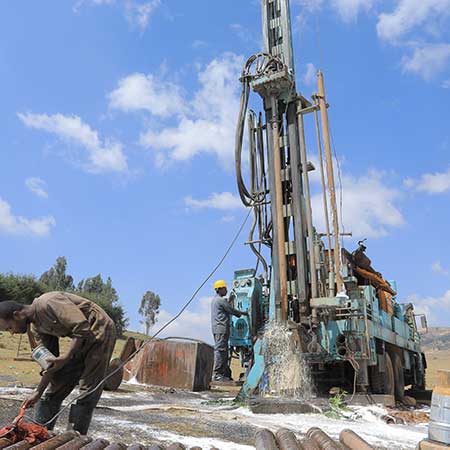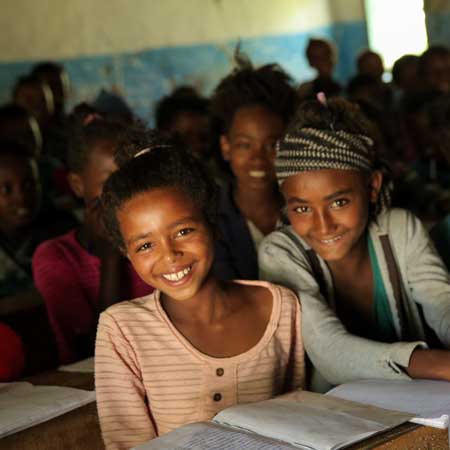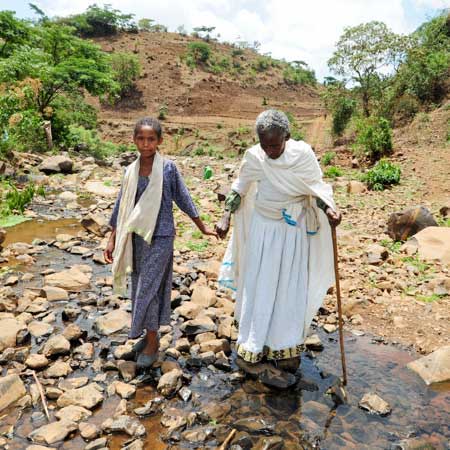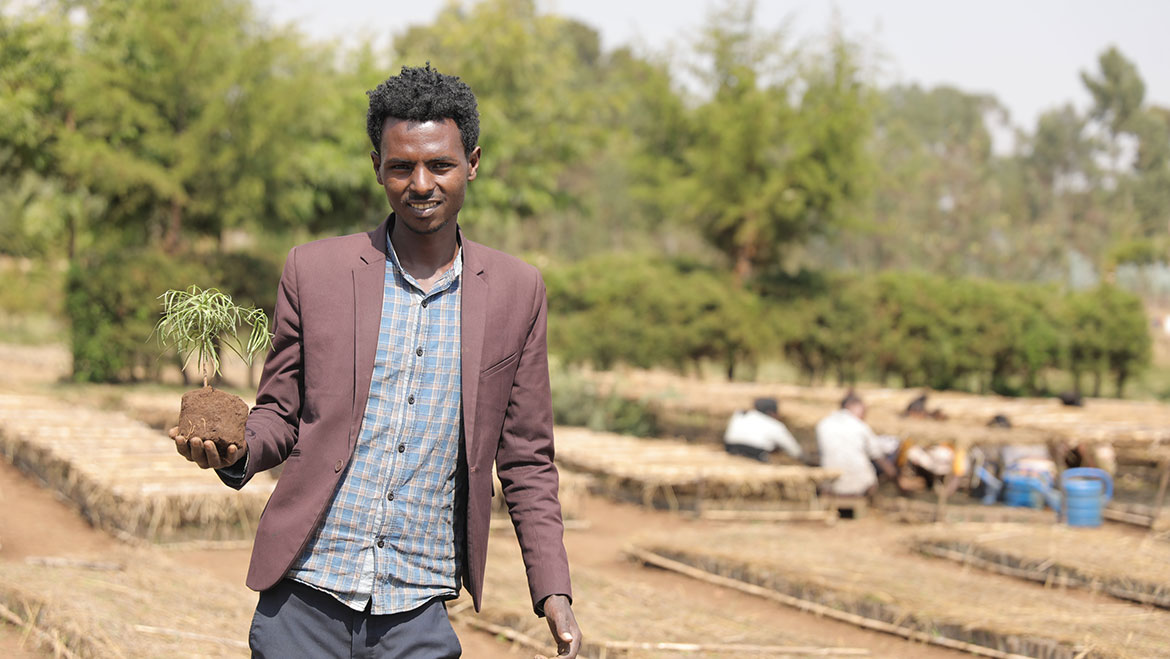
Nagaya Magazine 3/2020
Raised with love
When the forest disappears, so does life. In Ethiopia, soil erosion is threatening the population and the environment. Thanks to the efforts of many committed people, a stop can be put to this and new life be allowed to flourish.
Guto Andode is abuzz with commotion. Almost a dozen men have gathered around Menschen für Menschen employee Abayneh Aleme. “The erosion ditch expanded by around 40 meters in the last rainy season,” says Abayneh, explaining the displeasure of those present. “Thirteen families are already affected by it, the fields are literally collapsing in front of them.” Abayneh is responsible for agricultural projects in the project regions of Abune Ginde Beret and Ginde Beret, and tells the men how they can keep the erosion ditch in check. “The land should stop being used as pasture for animals. That means it has to be fenced off. Only then does it make sense to use gabions (metal baskets filled with stones), which trap the soil here, and to plants shrubs and trees.”

Samuel works as a foreman at a Menschen für Menschen nursery. “Seeing seedlings grow is like watching children grow,” is how he describes the joy of his work.
Explaining the fencing
The first important step in any initiative is to get the community on board. In Guto Andode, that initially required some persuasion and explanation. That’s because grassland is important, and at first glance the fencing seems to exclude an important area. From a long-term perspective, the land will recover on its own, but the men from Guto Andode had to see that with their own eyes. That’s why Abayneh organized the tour of an enclosed erosion ditch in a neighboring community. “We looked at the ditch in Godo Dada and saw how effective the protection is. Trees have been planted there and gabions used to stop the ditch from expanding any further,” reports Tesfaye on the reconnaissance visit. “Families can even harvest grass there and use it as feed for their livestock.”
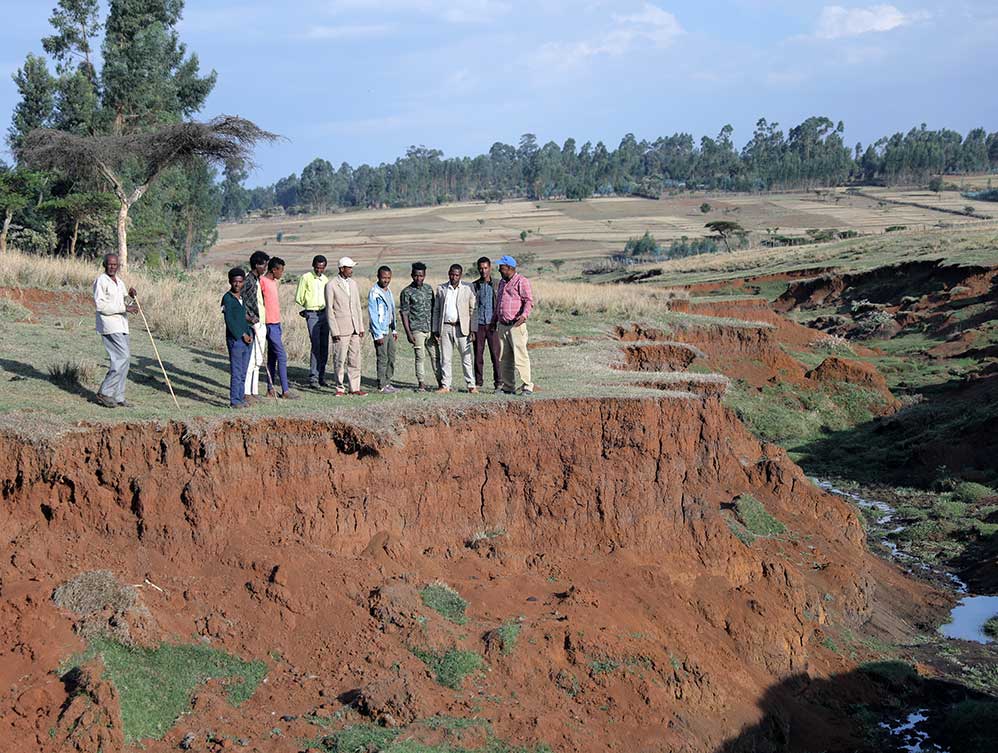
March 2019. The residents of Guto Andode were desperate. The giant erosion ditch was continuing to expand and threaten their fields.
Fields disappearing
Tesfaye’s family is particularly badly affected by the erosion ditch in Guto Andode: “I only have a small piece of land as it is. Just about a hectare. Now there’s just a tiny bit of it left and I have to rent a field in order to survive on any sort of level.” With this kind of lease, Tesfaye has to give half the harvest to the landowner under a system common in rural Ethiopia, where fertile land is becoming increasingly scarce.
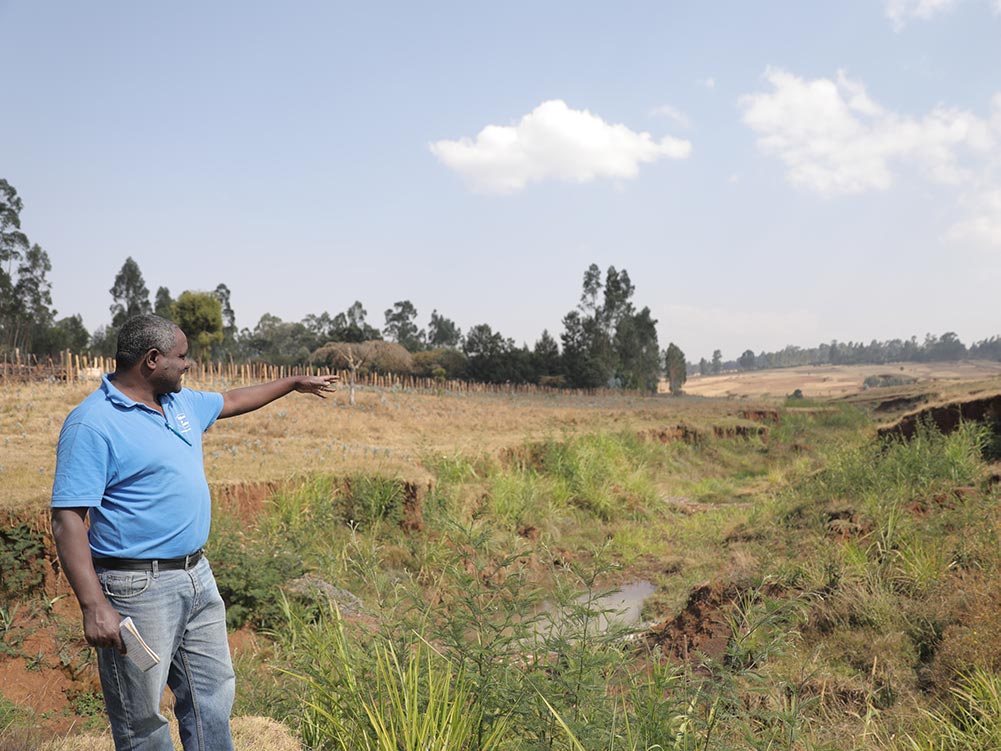
January 2020. With the help of Menschen für Menschen, the ditch was fenced off, gabions put in place, and the first seedlings planted. After eight months, the first signs of success are already evident.
Lost land
In Derra, about a 10-hour drive away, Abu can also lament how heavily degraded land has impaired his life and that of his community. “You see the red soil over there? It used to look like that everywhere around here!” Abu talks himself into a rage as he leads us through the enclosed ditch in the community of Kuyu. “The land was unusable as it was. No animal could have grazed here,” he says, shaking his head at how some people argue against the fencing. In Kuyu, the erosion ditch was fenced off 12 years ago and the one in the project region of Derra almost 10 years ago. Over the years, the ditch expansion has been halted through the use of gabions – wire baskets filled with stones – and refilled with soil. There are, of course, bridges that enable people to walk across the newly grown vegetation to look at the extent of the former threat. “A good five hectares were already affected when we asked Menschen für Menschen for help,” remembers Abu. “We then fenced off the area together, filled gabions, and planted seedlings such as spider flower and sisal. Today, we can see a lovely forest and the climate has changed.”
Nurseries for the future
The little plants used for reforestation come from nurseries that Menschen für Menschen has set up in each project region. In Derra, there was a total of 78. From there, around 20 million seedlings found their way to reforestation areas, fields or gardens during 13 years of project work. Nurseries are handed over to and run by the population or local authorities. They include the nursery in Cheka, where seedlings for reforesting the region are still grown today. Continuing the projects is the declared objective of the work done by Menschen für Menschen. Once the work is complete, the population should without external assistance be able independently to build on the foundations created. This goal has been achieved in Derra, as an external evaluation five years after completion of the work also confirmed. The audit carried out by the NPO & SE Competence Center of the Vienna University of Economics and Business in collaboration with the consultancy firm FAKT shows in detail that “the Menschen für Menschen initiatives have helped to spur positive and lasting developments that continue to exist and evolve five years after their completion.”
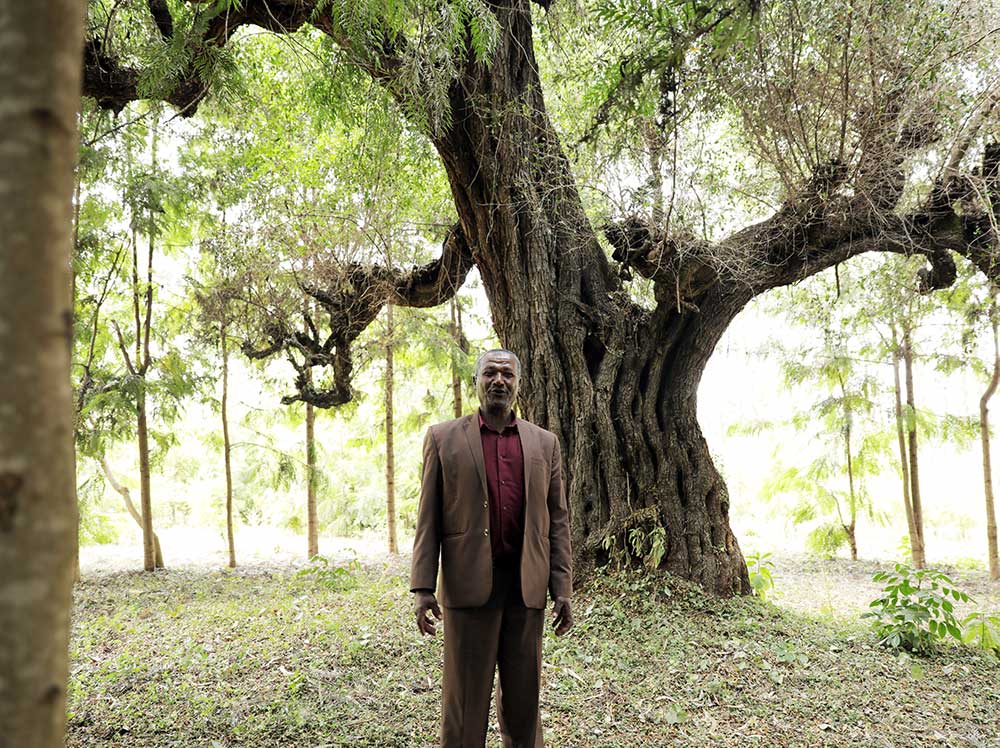
Mamo has transformed the field around a big old tree into a forest, with neighbors already taking a detour to enjoy its fresh climate.
Leading by example
People in Abune Ginde Beret also want to do justice to this good testimonial. Project leader Berhanu Bedassa previously worked in Derra and knows how important it is to involve the community in all projects from the outset, in order to achieve lasting success. Menschen für Menschen has set up 672 nurseries since 1981, 77 of them in Abune Ginde Beret where Berhanu and his employees have been implementing various initiatives with the local population since 2012. Many families have been able to establish a sound foundation since then, and serve as good examples for their neighbors. They include farmer Mamo, who can now be described as a forester. “Before, I only used to grow grain and beans on this field,” says the tall man as we stroll through a small wood. “Now the neighbors even take a detour to be able to walk through here,” laughs Mamo. “It’s so refreshing, almost like a swimming pool.”
Heavenly diversity
In the middle of the little wood which Mamo created in just eight years, is a small clearing where an imposing tree put down its roots many years ago. “I’d like to set up a small rest area here,” says the equally imposing Mamo, and we can imagine just what it would be like: relaxing here in the shade of the wood, perhaps enjoying a freshly brewed coffee made from beans that Mamo has harvested himself, as well as a juicy mango or an apple from his garden. Yes, that really sounds like heaven. The basis for the variety in Mamo’s fields can be found in the nurseries, where not only trees and shrubs are raised for forestation purposes, but also fruit trees and coffee seedlings.
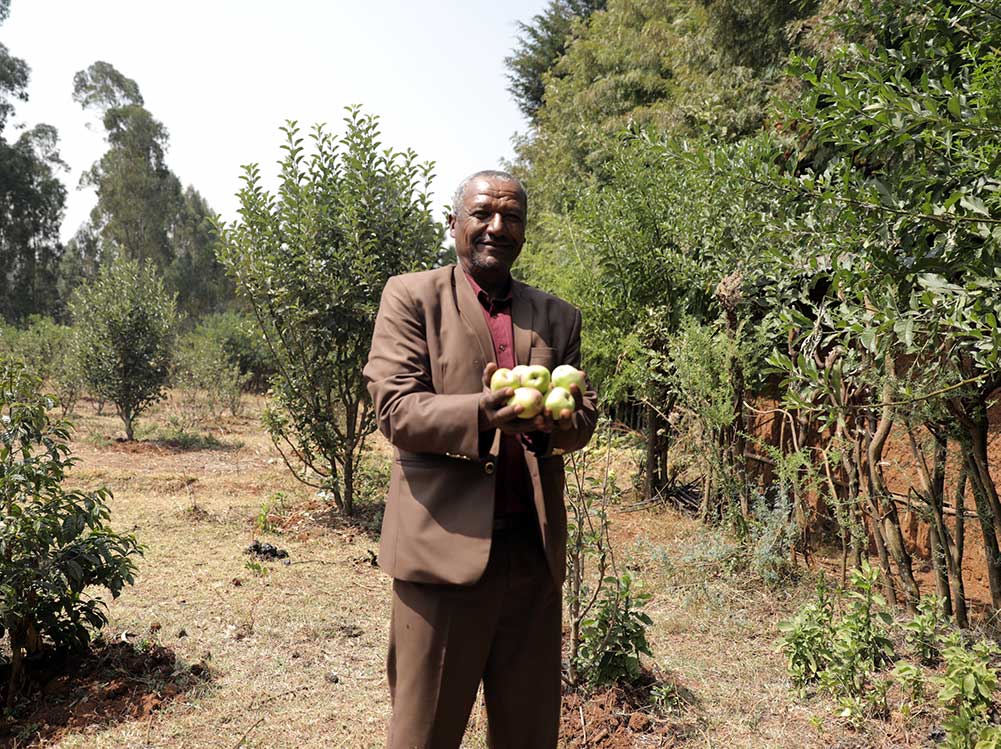
Farmer Mamo now harvests ample fruit and vegetables from his own garden.
600,000 seedlings raised by hand
Not far from Mamo’s forest pool, in the nursery of Kare Bite, we meet up with Samuel, who runs the business there as foreman. “I used to work in the nursery at Laga Banda. But that one was handed over to be run by the local church community,” says Samuel about the principle of Menschen für Menschen to hand over projects to the community step by step. “We raise about 600,000 seedlings a year here, from over 10 different species of tree,” explains Samuel, passing us a big heavy book in which he meticulously documents everything. “Which seedlings are sown and when depends on the sowing calendar. The olive tree, for example, is sown during the rainy season.”
Growing like children
Samuel has been working for Menschen für Menschen for five years and his enthusiasm for the work he does is truly infectious. “Before that, I went to secondary school in the neighboring region of Ginde Beret. I really like working here in the nursery and with the plants. I see to it that everything is prepared at the right time: getting the compost and the soil ready for sowing, and that there are also enough workers here. Like me, they all come from the region and are employed as required.” While Samuel carefully holds a seedling of his favorite tree, the Birbisa*, in his hands, he gives us another really nice reason for his motivation: “Seeing seedlings grow is like watching children grow.”


